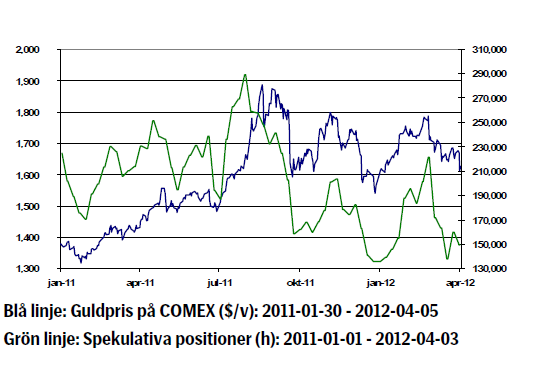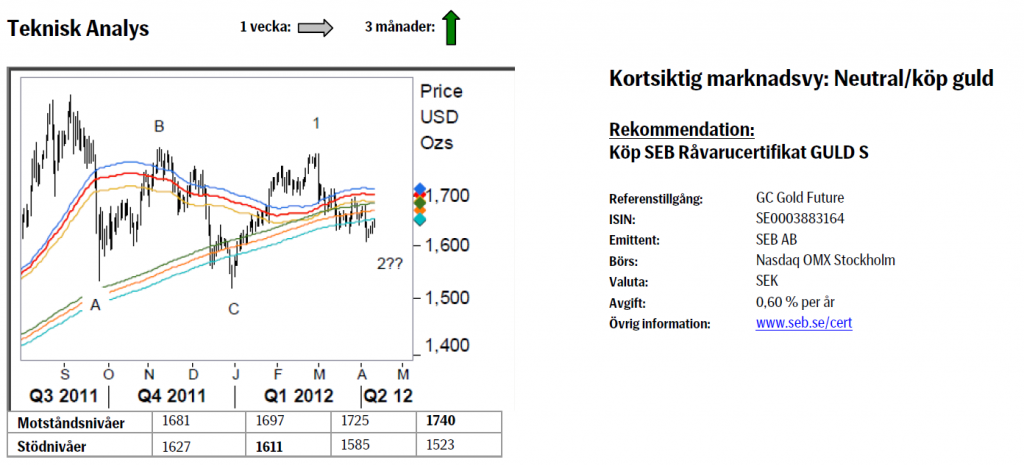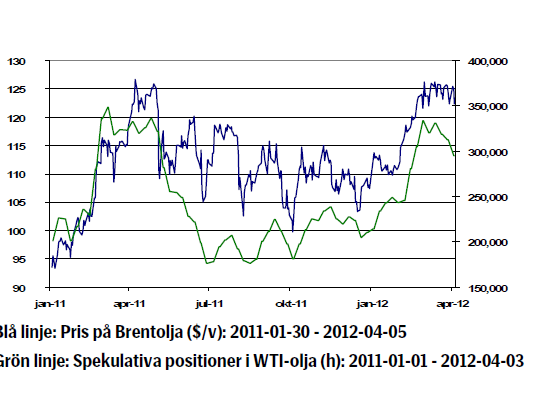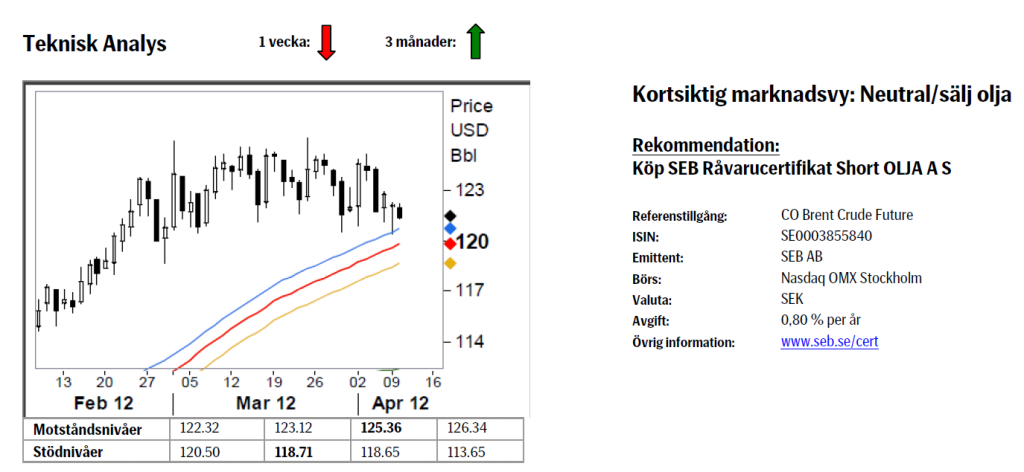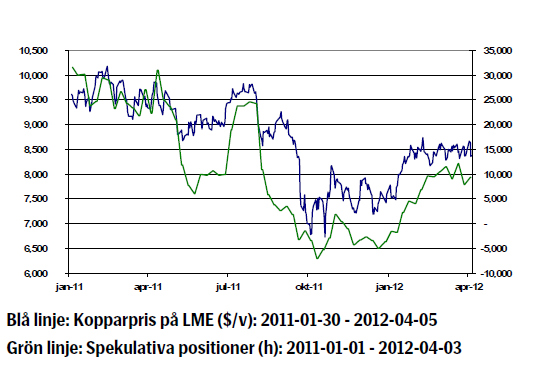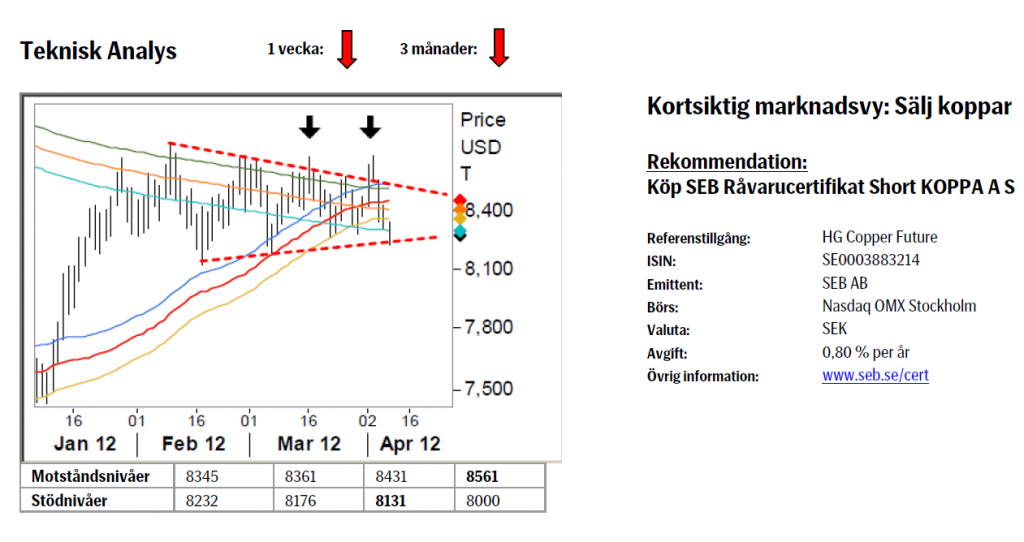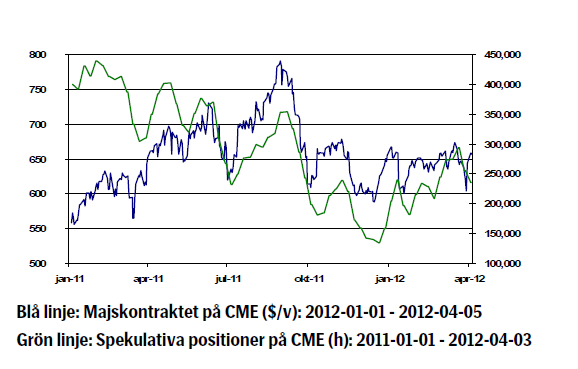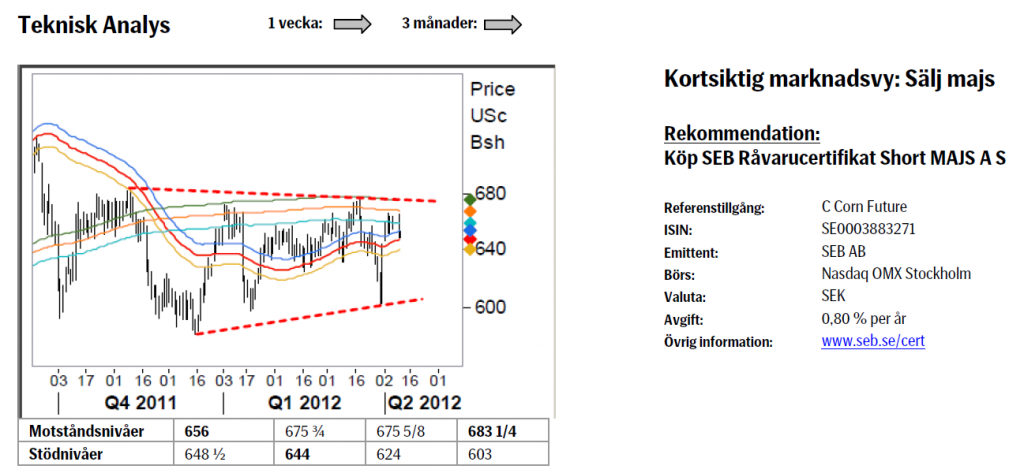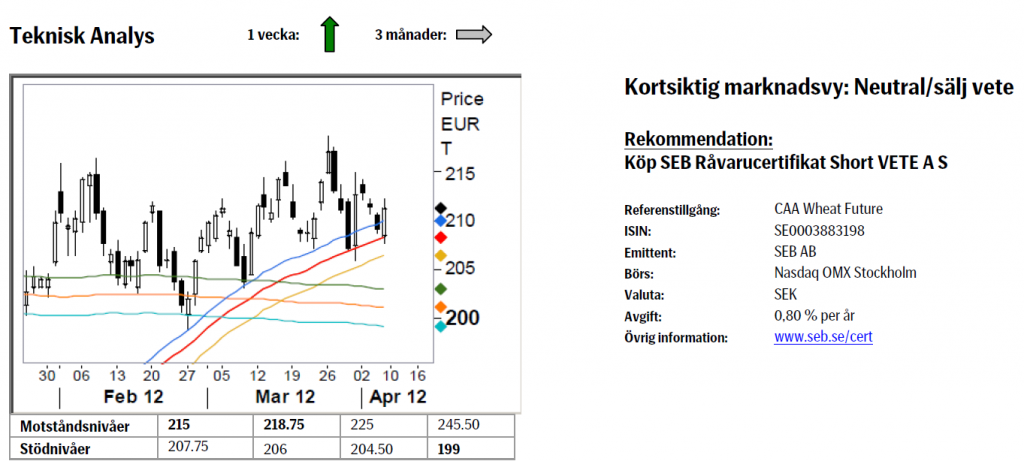Analys
SEB – Råvarukommentarer vecka 15 2012
Sammanfattning: Föregående vecka
 Brett råvaruindex: -0,10 %
Brett råvaruindex: -0,10 %
UBS Bloomberg CMCI TR Index- Energi: +0,28 %
UBS Bloomberg CMCI Energy TR Index - Ädelmetaller: -2,46 %
UBS Bloomberg CMCI Precious Metals TR Index - Industrimetaller: -0,22 %
UBS Bloomberg CMCI Industrial Metals TR Index - Jordbruk: -0,06 %
UBS Bloomberg CMCI Agriculture TR Index
Kortsiktig marknadsvy:
- Guld: Neutral/köp
- Olja: Neutral/sälj
- Koppar: Sälj
- Majs: Sälj
- Vete: Neutral/sälj
Guld
- Guldpriset föll 1,5 procent förra veckan och nådde på onsdagen tillfälligt 1614 dollar, den lägsta nivån på 12 veckor. Nedtonade förväntningar om ytterligare stimulanser från Federal Reserve fick guldet att falla och dollarn steg mot de flesta övriga valutor.
- Ekonomin utvecklas svagt i Europa, vilket avspeglas i ett svagt inköpschefsindex. Detta låg för mars månad under den nivå som indikerar en industriell expansion.
- Vidare har oron för Spanien tagit fart igen. Landet har svårt att nå tillräckliga besparingar för att få bukt med ett allt för stort budgetunderkott. Detta samtidigt som Tyskland ser en stigande inflation på grund av de största löneökningarna på 20 år.
- I Indien fortsätter juvelerarnas strejk, vilken nu har pågått i två veckor. Strejken är en protest mot en nytillkommen ökning på skatten av obearbetat importerat guld. Kortsiktigt bör dock inte guldpriset påverkas nämnvärt av strejken.
- Fredagens amerikanska arbetsmarknadssiffror kom ut sämre än förväntat och öppnar upp för nya spekulationer avseende ett nytt paket av kvantitativa lättnader i USA. Detta bör kunna ge stöd åt guldet den närmaste tiden.
- Teknisk Analys: Marknaden har utvecklats något svagare under den senaste veckan då vi fallit och stannat under den nedre delen av medelvärdesbanden. Detta förändrar dock ingenting i det större perspektivet varför vi fortsätter vårt sökande efter slutet på innevarande korrektion. För att den långsiktigt positiva bilden ska ändras krävs det att våg C’s botten bryts.
Olja
- Oljepriset föll med 1,6 procent förra veckan. Goda industrisignaler från USA bidrog till att oljepriset lyfte i början av veckan, men oljan backade kraftigt på tisdagen efter dämpade förväntningar om nya penningpolitiska lättnader i landet. Ska ytterligare lättnadsåtgärder behövas i USA anser Fed att ekonomin ska försämras ytterligare och inflationen bör sjunka under två procent.
- Statistik från American Petroleum Institute (API) visade att lagren av amerikansk råolja steg med 7,8 miljoner fat till den högsta nivån sedan juli 2007. Den lagerstatistik som energidepartementet presenterade på onsdagen visade att lagren av råolja steg med 9 miljoner fat.
- Saudiarabien har annonserat att man inte kommer att dra ned på oljeexporten. Detta kommer inte ens ske om man i väst väljer att öppna upp sina strategiska oljereserver. Enligt Reuters producerade Saudiarabien 10 miljoner fat per dag under mars, vilket bidrog till ökade råoljelager.
- Fredagens arbetsmarknadsstatistik från USA för mars blev en besvikelse och antalet sysselsatta ökade med endast 120 000 personer. Förvisso föll arbetslösheten, men förbättringen kan främst relateras till ett lägre arbetsdeltagande. Oljepriset föll tillsammans med aktier och råvaror på denna nyhet.
- Teknisk Analys: Efter det misslyckade brottet upp ur den triangellika formationen (samma som i koppar) har vi nu rört oss nedåt och kommit fram till stöd området. Givet det falska brottet norrut kan vi nog med tillförsikt se an ett brott söderut. Dessutom, i och med den senaste utvecklingen, ser hela formationen ut att ta formen av en rundad topp.
Koppar
- Kopparpriset föll med 3,3 procent förra veckan. Under början av veckan steg dock priset efter oväntat starka PMI-siffror från Kina (53.1 mot förväntat 50.8), men efter att Federal Reserve signalerat om återhållsam penningpolitik föll metallen tillsammans med övriga marknader under den fortsatta veckan.
- Enligt Bloomberg steg LME:s kopparlager förra veckan. Marknaden förväntar sig högre lagernivåer, detta då efterfrågan på koppar från Kina har dämpats den senaste tiden. Kinesisk kopparimport föll i mars jämfört med föregående månad som en konsekvens av höga inhemska kopparlager. Kina står för närvarande för cirka 40 procent av världens kopparkonsumtion.
- Under mars månad överraskade Kinas inflation på uppsidan, detta efter att priserna har stigit med 3.6% under de senaste 12 månaderna. Siffran minskar sannolikheten för ytterligare monetära stimulanser.
- En del befarar nu att den kinesiska ekonomin är på väg mot en kraftigare inbromsning än vad man tidigare förväntat sig. Även om landets export- och importtillväxt är fortsatt positiv god har vi kunnat se en väsentlig inbromsning, vilket tynger kopparpriset. Med detta sagt bibehåller vi vår säljrekommendation.
- Teknisk Analys: Efter att två gånger ha brutit upp ur triangeln och båda gångerna omedelbart tvingats till reträtt får vi nog anse att nedåtrisken för innevarande vecka är stor, ja till och med mycket stor (falska brott ur ett intervall leder ofta till ett brott i motsatt riktning). Så ett varningen finger är nog på sin plats skulle 8131 stödet ge vika.
Majs
- Vår vy om en påskvecka utan tydlig riktning, men med positiva undertoner, visade sig stämma ganska väl. Priset fortsatte på måndagen upp något i efterdyningarna av fredagens kraftiga uppgång, men har sedan dess legat runt 6,5 USD/bushel.
- Enligt Bloomberg ser det denna vecka ljust ut för planteringen av den amerikanska majsskörden. Det varma och torra vädret öppnar upp för en tidig plantering, vilket i regel brukar innebära god avkastning för majsen.
- Enligt det amerikanska jordbruksdepartementet (USDA) har de amerikanska bönderna nu planterat 7 % av sin majs. Förra året hade 3 % planterats vid denna tidpunkt och snittet för de senaste 5 åren ligger på 2 %.
- Även om investerarna efter de senaste veckornas positiva prisutveckling bör återvända till majsmarknaden tror vi inte att detta kommer att kunna ge något starkare stöd åt priset. Man ska inte glömma att den befintliga lagernivån är låg och efterfrågan fortsatt god, men detta bör vara väl inprisat och således ligger risken på nedsidan de kommande veckorna.
- Teknisk Analys: Efter den kraftfulla studsen den 30/3 har marknaden i princip gjort ingenting. För att utlösa någon nämnvärd aktivitet måste nog vi bryta antingen över 675 ¾ eller under 624 ½. Däremellan råder stiltje.
Vete
- Till skillnad från majsen orkade inte vetepriset hålla sig kvar på de nivåer som vi kunde se i början av veckan. Vinsthemtagningar tillsammans med förbättrade utsikter för den amerikanska produktionen av vintervete tryckte priset nedåt.
- Kvaliteten på det amerikanska vintervetet får än så länge anses vara förhållandevis god. Enligt söndagens rapport från USDA är 10 % av skörden dålig eller mycket dålig. Detta kan jämföras med förra året då motsvarande siffra var 36 %. (Vintervetet odlas under hösten/vintern och skördas under sommaren.)
- Planteringen av det amerikanska vårvetet går mycket bra. Enligt USDA:s senaste rapport har 21 % planterats. Förra året hade 3 % av vårvetet planterats vid denna tidpunkt och snittet för de senaste 5 åren ligger på 5 %. (Vårvetet planteras under våren och skördas på sensommaren.)
- Vidare gick den amerikanska exporten av vete ned något under föregående vecka, vilket tyder på en något svagare efterfrågan på vete.
- Fundamentalt bedömer att utsikterna för vete denna vecka är negativa, men de tekniska signalerna gör oss återhållsamma.
- Teknisk Analys: Även ett andra besök i 55dagarsbandet renderade köpande, något som vi lägger på det positiva kontot. Nästa steg bör bli att ta ut 215 motståndet och därefter stör dörren vidöppen för nya trendtoppar.
[box]SEB Veckobrev Veckans råvarukommentar är producerat av SEB Merchant Banking och publiceras i samarbete och med tillstånd på Råvarumarknaden.se[/box]
Disclaimer
The information in this document has been compiled by SEB Merchant Banking, a division within Skandinaviska Enskilda Banken AB (publ) (“SEB”).
Opinions contained in this report represent the bank’s present opinion only and are subject to change without notice. All information contained in this report has been compiled in good faith from sources believed to be reliable. However, no representation or warranty, expressed or implied, is made with respect to the completeness or accuracy of its contents and the information is not to be relied upon as authoritative. Anyone considering taking actions based upon the content of this document is urged to base his or her investment decisions upon such investigations as he or she deems necessary. This document is being provided as information only, and no specific actions are being solicited as a result of it; to the extent permitted by law, no liability whatsoever is accepted for any direct or consequential loss arising from use of this document or its contents.
About SEB
SEB is a public company incorporated in Stockholm, Sweden, with limited liability. It is a participant at major Nordic and other European Regulated Markets and Multilateral Trading Facilities (as well as some non-European equivalent markets) for trading in financial instruments, such as markets operated by NASDAQ OMX, NYSE Euronext, London Stock Exchange, Deutsche Börse, Swiss Exchanges, Turquoise and Chi-X. SEB is authorized and regulated by Finansinspektionen in Sweden; it is authorized and subject to limited regulation by the Financial Services Authority for the conduct of designated investment business in the UK, and is subject to the provisions of relevant regulators in all other jurisdictions where SEB conducts operations. SEB Merchant Banking. All rights reserved.
Analys
Tightening fundamentals – bullish inventories from DOE

The latest weekly report from the US DOE showed a substantial drawdown across key petroleum categories, adding more upside potential to the fundamental picture.

Commercial crude inventories (excl. SPR) fell by 5.8 million barrels, bringing total inventories down to 415.1 million barrels. Now sitting 11% below the five-year seasonal norm and placed in the lowest 2015-2022 range (see picture below).
Product inventories also tightened further last week. Gasoline inventories declined by 2.1 million barrels, with reductions seen in both finished gasoline and blending components. Current gasoline levels are about 3% below the five-year average for this time of year.
Among products, the most notable move came in diesel, where inventories dropped by almost 4.1 million barrels, deepening the deficit to around 20% below seasonal norms – continuing to underscore the persistent supply tightness in diesel markets.
The only area of inventory growth was in propane/propylene, which posted a significant 5.1-million-barrel build and now stands 9% above the five-year average.
Total commercial petroleum inventories (crude plus refined products) declined by 4.2 million barrels on the week, reinforcing the overall tightening of US crude and products.


Analys
Bombs to ”ceasefire” in hours – Brent below $70

A classic case of “buy the rumor, sell the news” played out in oil markets, as Brent crude has dropped sharply – down nearly USD 10 per barrel since yesterday evening – following Iran’s retaliatory strike on a U.S. air base in Qatar. The immediate reaction was: “That was it?” The strike followed a carefully calibrated, non-escalatory playbook, avoiding direct threats to energy infrastructure or disruption of shipping through the Strait of Hormuz – thus calming worst-case fears.

After Monday morning’s sharp spike to USD 81.4 per barrel, triggered by the U.S. bombing of Iranian nuclear facilities, oil prices drifted sideways in anticipation of a potential Iranian response. That response came with advance warning and caused limited physical damage. Early this morning, both the U.S. President and Iranian state media announced a ceasefire, effectively placing a lid on the immediate conflict risk – at least for now.
As a result, Brent crude has now fallen by a total of USD 12 from Monday’s peak, currently trading around USD 69 per barrel.
Looking beyond geopolitics, the market will now shift its focus to the upcoming OPEC+ meeting in early July. Saudi Arabia’s decision to increase output earlier this year – despite falling prices – has drawn renewed attention considering recent developments. Some suggest this was a response to U.S. pressure to offset potential Iranian supply losses.
However, consensus is that the move was driven more by internal OPEC+ dynamics. After years of curbing production to support prices, Riyadh had grown frustrated with quota-busting by several members (notably Kazakhstan). With Saudi Arabia cutting up to 2 million barrels per day – roughly 2% of global supply – returns were diminishing, and the risk of losing market share was rising. The production increase is widely seen as an effort to reassert leadership and restore discipline within the group.
That said, the FT recently stated that, the Saudis remain wary of past missteps. In 2018, Riyadh ramped up output at Trump’s request ahead of Iran sanctions, only to see prices collapse when the U.S. granted broad waivers – triggering oversupply. Officials have reportedly made it clear they don’t intend to repeat that mistake.
The recent visit by President Trump to Saudi Arabia, which included agreements on AI, defense, and nuclear cooperation, suggests a broader strategic alignment. This has fueled speculation about a quiet “pump-for-politics” deal behind recent production moves.
Looking ahead, oil prices have now retraced the entire rally sparked by the June 13 Israel–Iran escalation. This retreat provides more political and policy space for both the U.S. and Saudi Arabia. Specifically, it makes it easier for Riyadh to scale back its three recent production hikes of 411,000 barrels each, potentially returning to more moderate increases of 137,000 barrels for August and September.
In short: with no major loss of Iranian supply to the market, OPEC+ – led by Saudi Arabia – no longer needs to compensate for a disruption that hasn’t materialized, especially not to please the U.S. at the cost of its own market strategy. As the Saudis themselves have signaled, they are unlikely to repeat previous mistakes.
Conclusion: With Brent now in the high USD 60s, buying oil looks fundamentally justified. The geopolitical premium has deflated, but tensions between Israel and Iran remain unresolved – and the risk of missteps and renewed escalation still lingers. In fact, even this morning, reports have emerged of renewed missile fire despite the declared “truce.” The path forward may be calmer – but it is far from stable.
Analys
A muted price reaction. Market looks relaxed, but it is still on edge waiting for what Iran will do

Brent crossed the 80-line this morning but quickly fell back assigning limited probability for Iran choosing to close the Strait of Hormuz. Brent traded in a range of USD 70.56 – 79.04/b last week as the market fluctuated between ”Iran wants a deal” and ”US is about to attack Iran”. At the end of the week though, Donald Trump managed to convince markets (and probably also Iran) that he would make a decision within two weeks. I.e. no imminent attack. Previously when when he has talked about ”making a decision within two weeks” he has often ended up doing nothing in the end. The oil market relaxed as a result and the week ended at USD 77.01/b which is just USD 6/b above the year to date average of USD 71/b.

Brent jumped to USD 81.4/b this morning, the highest since mid-January, but then quickly fell back to a current price of USD 78.2/b which is only up 1.5% versus the close on Friday. As such the market is pricing a fairly low probability that Iran will actually close the Strait of Hormuz. Probably because it will hurt Iranian oil exports as well as the global oil market.
It was however all smoke and mirrors. Deception. The US attacked Iran on Saturday. The attack involved 125 warplanes, submarines and surface warships and 14 bunker buster bombs were dropped on Iranian nuclear sites including Fordow, Natanz and Isfahan. In response the Iranian Parliament voted in support of closing the Strait of Hormuz where some 17 mb of crude and products is transported to the global market every day plus significant volumes of LNG. This is however merely an advise to the Supreme leader Ayatollah Ali Khamenei and the Supreme National Security Council which sits with the final and actual decision.
No supply of oil is lost yet. It is about the risk of Iran closing the Strait of Hormuz or not. So far not a single drop of oil supply has been lost to the global market. The price at the moment is all about the assessed risk of loss of supply. Will Iran choose to choke of the Strait of Hormuz or not? That is the big question. It would be painful for US consumers, for Donald Trump’s voter base, for the global economy but also for Iran and its population which relies on oil exports and income from selling oil out of that Strait as well. As such it is not a no-brainer choice for Iran to close the Strait for oil exports. And looking at the il price this morning it is clear that the oil market doesn’t assign a very high probability of it happening. It is however probably well within the capability of Iran to close the Strait off with rockets, mines, air-drones and possibly sea-drones. Just look at how Ukraine has been able to control and damage the Russian Black Sea fleet.
What to do about the highly enriched uranium which has gone missing? While the US and Israel can celebrate their destruction of Iranian nuclear facilities they are also scratching their heads over what to do with the lost Iranian nuclear material. Iran had 408 kg of highly enriched uranium (IAEA). Almost weapons grade. Enough for some 10 nuclear warheads. It seems to have been transported out of Fordow before the attack this weekend.
The market is still on edge. USD 80-something/b seems sensible while we wait. The oil market reaction to this weekend’s events is very muted so far. The market is still on edge awaiting what Iran will do. Because Iran will do something. But what and when? An oil price of 80-something seems like a sensible level until something do happen.
-

 Nyheter4 veckor sedan
Nyheter4 veckor sedanStor uppsida i Lappland Guldprospekterings aktie enligt analys
-

 Nyheter4 veckor sedan
Nyheter4 veckor sedanSilverpriset släpar efter guldets utveckling, har mer uppsida
-

 Nyheter3 veckor sedan
Nyheter3 veckor sedanUppgången i oljepriset planade ut under helgen
-

 Nyheter2 veckor sedan
Nyheter2 veckor sedanMahvie Minerals växlar spår – satsar fullt ut på guld
-

 Nyheter3 veckor sedan
Nyheter3 veckor sedanLåga elpriser i sommar – men mellersta Sverige får en ökning
-

 Analys3 veckor sedan
Analys3 veckor sedanVery relaxed at USD 75/b. Risk barometer will likely fluctuate to higher levels with Brent into the 80ies or higher coming 2-3 weeks
-

 Nyheter2 veckor sedan
Nyheter2 veckor sedanOljan, guldet och marknadens oroande tystnad
-

 Nyheter2 veckor sedan
Nyheter2 veckor sedanJonas Lindvall är tillbaka med ett nytt oljebolag, Perthro, som ska börsnoteras


